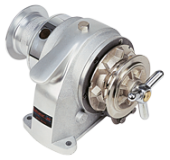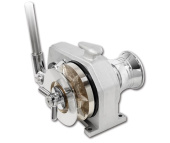A manual anchor windlass, also known simply as a manual windlass, is a mechanical device used for raising and lowering the anchor on a boat manually. Typically operated by hand, it offers a traditional yet reliable method for managing anchoring tasks. Manual windlasses are often constructed from durable materials such as stainless steel or bronze to withstand the harsh marine environment. They are commonly found on smaller vessels or as backup systems on larger boats. With a simple design and straightforward operation, manual windlasses provide boaters with a cost-effective solution for anchoring their vessels securely.
|
1-2 weeks delivery time The Lofrans Royal Manual Anchor Windlass is a sturdy, double-action horizontal windlass designed for boats from 8 to 12 m LOA. Built from marine-grade anodised aluminium, it supports 6 mm, 8 mm, and 10 mm chain (ISO 4565 / DIN766). With independent gypsy and drum operation, manual chain release, and manual override, it ensures safe and efficient anchoring. The windlass provides a maximum pull of 400 kg and a working load of 200–250 kg, with lifetime lubrication for long-term reliability.
|
$ 1.139,99
Diameter, mm:
| |||
|
1-2 weeks delivery time The Italwinch Giglio Manual Anchor Windlass is designed for boats ranging from 5 to 12 meters in length, providing effortless manual operation for smooth and reliable anchoring. This windlass accommodates chains of 6, 8, and 10 mm thickness and is built with a durable anodized aluminum body and a precision chain roller. It’s the perfect choice for boats requiring easy handling and reliability in marine environments.
|
Size, mm:
| |||
How does a vertical windlass differ from a horizontal windlass in terms of design and operation?
A vertical windlass differs from a horizontal windlass primarily in its orientation and operation. While a horizontal windlass typically sits parallel to the deck, a vertical windlass is mounted vertically, requiring less horizontal space. The vertical design allows for a more compact installation, making it suitable for smaller boats or where space is limited on the deck. Additionally, vertical windlasses often feature a double-action mechanism for smoother retrieval and better anchor handling, enhancing safety and convenience during anchoring operations.
A vertical windlass offers distinct advantages over horizontal counterparts in various aspects. Its vertical orientation facilitates easier installation, particularly in confined spaces like the cockpit or bow locker. With its efficient design and smooth operation, the vertical windlass ensures accessibility and convenience, providing boat owners with a cost-effective and reliable solution for anchor handling.
For a dependable and space-saving anchoring solution, explore our Pontoon Anchor Winch, designed for efficient and secure anchoring.
How does the design of a Lofrans Royal Manual Anchor Windlass ensure smoother operation and momentum when retrieving the anchor?
The design of a manual anchor windlass ensures smoother operation and momentum during anchor retrieval through several key features. The gypsy, capstan, and chainwheel are meticulously crafted to provide optimal grip and control over the anchor rode, allowing for efficient retrieval even in challenging conditions. Additionally, the stainless steel operating lever, often equipped with a comfortable grip, enables boaters to exert sufficient force and leverage, translating to smoother and more controlled movement when getting the anchor onboard. This design ensures that manual anchor windlasses offer a safer and more reliable means of anchor handling, making them a preferred choice for many boaters seeking simplicity and effectiveness in their anchoring setup.
The manual anchor windlass design not only ensures smoother operation and momentum but also provides an inexpensive way to add better anchor handling to any boat. With its sturdy construction and efficient mechanisms like the clutch and pawl, manual windlasses offer reliable performance during anchor retrieval, whether in calm waters or rough conditions. Boaters seeking simplicity and effectiveness in their anchoring setup can rely on manual anchor windlasses, which are available for installation with ease and can be tailored to specific boat specifications upon special order. Additionally, manufacturers prioritize customer service, ensuring that boaters receive the necessary support and assistance for a hassle-free experience on the water.
What are the distinguishing features of manual anchor windlasses compared to electric ones?
Manual anchor windlasses offer several distinguishing features compared to their electric counterparts. Firstly, they provide a simple and inexpensive way to enhance anchor handling capabilities, making them accessible to a wide range of boat owners. Unlike electric windlasses, manual ones rely on the operating lever with a comfortable grip, allowing users to exert physical effort to haul the anchor and get the boat moving. Additionally, manual anchor windlasses typically require a different level of capability and expertise for installation and operation, making them a popular choice for those seeking a more hands-on approach to anchoring.
In addition to their simplicity and accessibility, manual anchor windlasses offer distinct advantages over electric ones in various aspects. Their manual operation allows for greater control and precision, particularly in challenging conditions where maneuvering is crucial. Unlike electric windlasses, which may be limited by power sources or technical malfunctions, manual windlasses offer reliability and dependability, ensuring that boaters can confidently handle anchoring tasks. With their sturdy construction and efficient mechanisms, manual anchor windlasses are a practical choice for boat owners seeking a reliable and straightforward solution for anchoring, whether for occasional use or frequent cruising.


